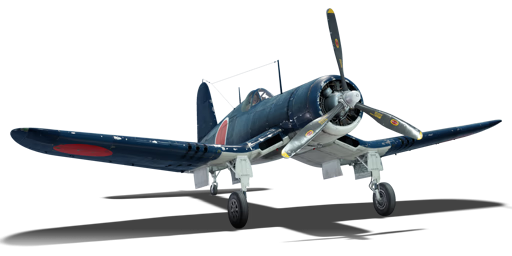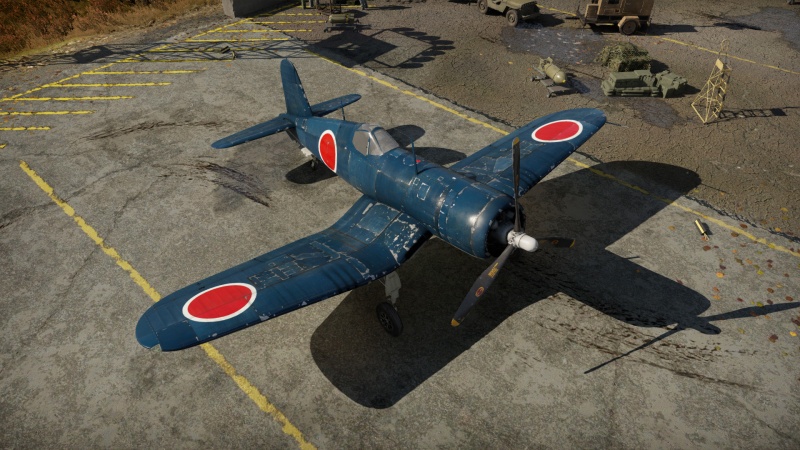F4U-1A (Japan)
| This page is about the premium fighter F4U-1A (Japan). For the American version, see F4U-1A. For other uses, see F4U (Family). |
Contents
Description
The F4U Corsair was a single-engine fighter that excelled in top-speed performance and fire power. It was a shock to Japanese pilots who were familiar with obsolete aircraft like the F4F Wildcat and F2A Buffalo. As was typical with aerial combat in World War II, some planes faced mechanical problems or damage that forced pilots to crash land. This led to Japanese forces capturing various aircraft, like the P-40 Warhawk, B-17 Flying Fortress, and some Corsairs. Although specific details about the planes are hazy, it is known that Japan did have two Corsairs and fixed one to flying condition. The Japanese conducted various flight tests and were impressed by the materials used in construction and the flight performance.
The ▅F4U-1A Corsair has been premium in the game since the start of the Open Beta Test prior to Update 1.27. It is virtually the same as the F4U-1A in the American tech tree, with the exception of the camo used and the lack of suspended armament. Much like the American F4U-1A, the Japanese F4U-1A is an incredibly strong fighter thanks to its high-speed performance, armament, and overall handling. Players should take note of the F4U-1A's limited WEP capability (around 7-8 minutes) as a result of the water injection system used. This version of the Corsair comes armed with six 12.7 mm M2 Browning machine guns and ample ammunition, which is more than enough for its battle rating. Overall, the ▅F4U-1A Corsair is a strong aircraft, even though it lacks bombs for close air support.
General info
Flight performance
| Characteristics | Max speed (km/h at 7,000 m) |
Max altitude (metres) |
Turn time (seconds) |
Rate of climb (metres/second) |
Take-off run (metres) | |||
|---|---|---|---|---|---|---|---|---|
| AB | RB | AB | RB | AB | RB | |||
| Stock | 656 | 633 | 11247 | 25.1 | 25.9 | 8.8 | 8.8 | 251 |
| Upgraded | 715 | 683 | 23.0 | 24.0 | 16.8 | 12.3 | ||
Details
| Features | ||||
|---|---|---|---|---|
| Combat flaps | Take-off flaps | Landing flaps | Air brakes | Arrestor gear |
| ✓ | ✓ | ✓ | X | ✓ |
| Limits | ||||||
|---|---|---|---|---|---|---|
| Wings (km/h) | Gear (km/h) | Flaps (km/h) | Max Static G | |||
| Combat | Take-off | Landing | + | - | ||
| 885 | 730 | 388 | 330 | 252 | ~11 | ~4 |
| Optimal velocities (km/h) | |||
|---|---|---|---|
| Ailerons | Rudder | Elevators | Radiator |
| < 450 | < 450 | < 500 | > 450 |
Survivability and armour
- 3 mm steel covering central fuel tank
- 8 mm steel behind pilot
- 12.7 mm steel behind pilot's head
- 38 mm bulletproof glass
- Self-sealing fuel tanks (1 in each wing, 1 in front of pilot)
Modifications and economy
Armaments
Offensive armament
The F4U-1A (Japan) is armed with:
- 6 x 12.7 mm M2 Browning machine guns, wing-mounted (400 rpg inner + centre + 375 rpg outer = 2,350 total)
Usage in battles
Players should side climb in this plane and once at altitude, begin to dive down on enemies below. Due to the weight and aerodynamics of this aircraft, it is a fantastic Boom & Zoomer for the battle rating. With enough energy, no other comparable aircraft can catch it in a dive. When you have speed at your disposal, you can easily energy fight against higher-rank aircraft. Be aware that over speeds of approximately 550km/h the rudder is almost useless and if the target evades you it will be almost impossible to hit them. Using the aircraft's great flaps and energy retention allow the fighter to hang in the vertical much longer than other planes; it's here you can corner enemies into an energy trap. However, those who wish to take on the ▅F4U-1A Corsair in combat must make sure they go into the engagement with a significant energy advantage over your opponent or you may find yourself on the receiving end of a lead shower.
Manual Engine Control
| MEC elements | ||||||
|---|---|---|---|---|---|---|
| Mixer | Pitch | Radiator | Supercharger | Turbocharger | ||
| Oil | Water | Type | ||||
| Not controllable | Controllable Auto control available |
Controllable Not auto controlled |
Controllable Not auto controlled |
Separate | Controllable 3 gears |
Not controllable |
Pros and cons
Pros:
- Heavy armament of 6 x 12.7 mm machine guns
- Fantastic energy retention
- Extremely fast dive speed
Cons:
- Poor manoeuvrability for a fighter (heavy aircraft)
- No payload options
History
| Archive of the in-game description | |
|---|---|
|
Vought F4U-1A Corsair single-engine carrier-based fighter (IJNAF) A single-seat, single-engine carrier-based fighter; an all-metal cantilever monoplane with a peculiar inverted gull wing. It was designed in the design bureau of Chance Vought for a single-seat carrier-based fighter competition announced by the USNAF. The V-166B prototype fighter made its first flight on May 26, 1940. In June 1942, the F4U fighter entered mass production. In the middle of 1943, the F4U-1A variant began full-scale production. While creating this variant, Chance Vought's experts introduced some changes into the aircraft's design which contributed to its success as a carrier-based fighter. The main landing gear shock absorbers' stroke was increased, and their stiffness was reduced. The pilot's cockpit was drastically redesigned; to improve forward and rear visibility, which was especially important when landing on an aircraft carrier, the pilot's cockpit canopy was made convex, and the pilot's seat was raised 17.8 cm. The designers solved the problem of the fighter's stalling at near-minimum speeds in quite a simple way: a stall strip, 152 mm long, was fitted on the right wing in the area of the machine gun ports. When the left wing began to stall, which was typical of the F4U-1, this strip initiated flow separation over the right wing, leveling the aircraft out. The F4U-1A's armament consisted of six large-calibre 12.7 mm Colt-Browning ANM2.5 machine guns, three on each wing. The Corsair fighters were quite dangerous opponents for the Japanese fighters, so the Imperial Japanese Navy's experts wanted to take a closer look at the new American machine. The Japanese managed to capture two Corsair fighters which had made forced landings. One of them was an F4U-1A, and the planes had apparently belonged to the US Marine Corps and the Royal New Zealand Air Force. The Japanese successfully repaired one machine, using the second F4U as a source of spare parts and partially covering the damaged parts of the wing surfaces with canvas. This restored Corsair was flight-tested. After Japan surrendered, this machine was discovered by the Americans at the flying school airfield in Kasumigaura. | |
Media
- Skins
See also
Links to the articles on the War Thunder Wiki that you think will be useful for the reader, for example:
- reference to the series of the aircraft;
- links to approximate analogues of other nations and research trees.
External links
| Chance Vought Aircraft | |
|---|---|
| Fighters | |
| Corsair | F4U-1A · F4U-1A (USMC) · F4U-1C · F4U-1D · F4U-4 · F4U-4B · F4U-4B VMF-214 |
| Float planes | O3U-1 · OS2U-1 · OS2U-3 |
| Attackers | AU-1 |
| Bombers | SB2U-2 · SB2U-3 |
| Jet aircraft | |
| Corsair II | A-7D · A-7E · A-7K |
| Crusader | F8U-2 · F-8E |
| Export | V-156-B1 · V-156-F · ▄Corsair F Mk II · F4U-7 · ▄F-8E(FN) |
| Captured | ▅F4U-1A |
| Japan fighters | |
|---|---|
| Navy | |
| Carrier-based fighter | |
| A5M | A5M4 · Hagiri's A5M4 |
| A6M | A6M2 mod. 11 · A6M2 · A6M3 · A6M3 mod. 22 · A6M3 mod. 22Ko · A6M5 · A6M5 Ko · A6M5 otsu · A6M5 Hei · A6M6c |
| A7He | A7He1* |
| A7M | A7M1 (NK9H) · A7M2 |
| Land-based Fighter | |
| J2M | J2M2 · J2M3 · J2M4 Kai · J2M5 · J2M5 (30 mm) |
| J6K | J6K1 |
| J7W | J7W1 |
| N1K-J | N1K1-Ja · N1K2-J · N1K2-Ja |
| Fighter seaplane | |
| N1K | N1K1 |
| A6M-N | A6M2-N |
| Army | |
| Ki-10 | Ki-10-I · Ki-10-I C · Ki-10-II · Ki-10-II C |
| Ki-27 | Ki-27 otsu · Ki-27 otsu Tachiarai |
| Ki-43 | Ki-43-I · Ki-43-II · Ki-43-III otsu |
| Ki-44 | Ki-44-I · Ki-44-I 34 · Ki-44-II otsu · Ki-44-II hei |
| Ki-61 | Ki-61-I ko · Ki-61-I otsu · Ki-61-I hei · Tada's Ki-61-I hei · Ki-61-I tei · Ki-61-II Otsu Kai |
| Ki-84 | Ki-84 ko · Ki-84 otsu · Ki-84 hei |
| Ki-87 | Ki-87 |
| Ki-94 | Ki-94-II |
| Ki-100 | Ki-100 · Ki-100-II |
| Other countries | ▅F4U-1A · ▅P-51C-11-NT · ▅Bf 109 E-7 · ▅Fw 190 A-5 |
| *Imported designation of the He 112 (A6M was in development - A7M would take A7 designation after the cancelation of the A7He) | |
| Japan premium aircraft | |
|---|---|
| Fighters | Hagiri's A5M4 · A7He1 · Ki-27 otsu Tachiarai |
| Ki-44-II otsu · ▅Bf 109 E-7 · ▅F4U-1A · Ki-100-II · Ki-44-I 34 | |
| ▅Fw 190 A-5 · A7M1 (NK9H) · Tada's Ki-61-I hei · ▅P-51C-11-NT | |
| J2M4 Kai · A6M5 Ko · A6M6c · J2M5 · Ki-87 · J6K1 | |
| Twin-engine fighters | Ki-96 |
| Jet fighters | F-86F-40 JASDF▅ · T-2 Early · F-4EJ ADTW |
| Strike aircraft | ▄AV-8S |
| Bombers | Ki-21-I hei · Ki-48-II otsu · H8K3 · B7A2 (Homare 23) · ▅B-17E |





